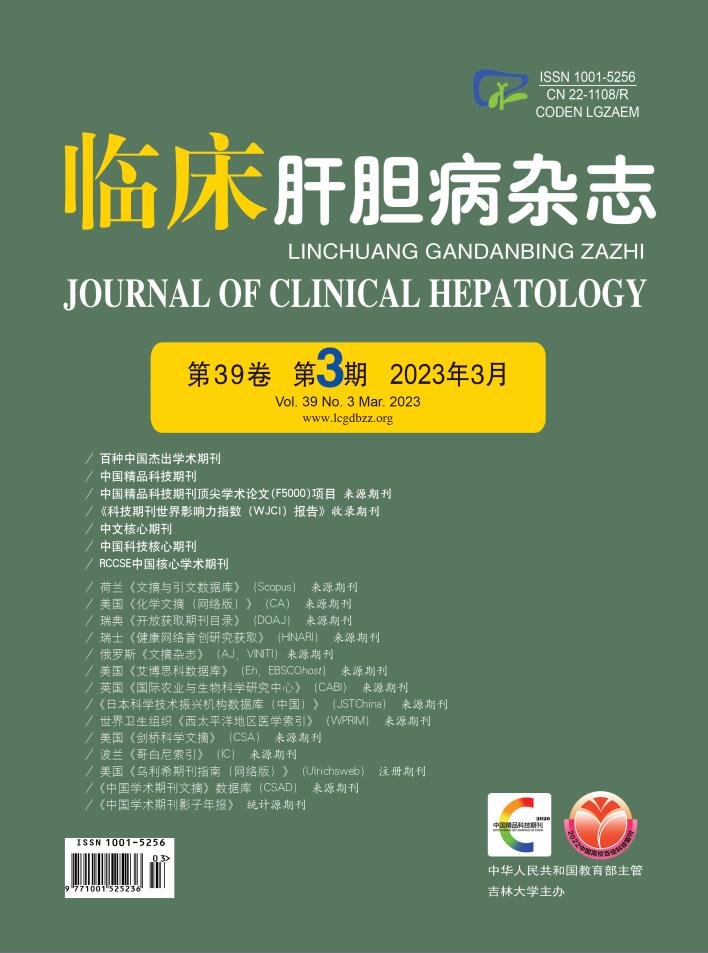| [1] |
BOIKE JR, THORNBURG BG, ASRANI SK, et al. North American practice-based recommendations for transjugular intrahepatic portosystemic shunts in portal hypertension[J]. Clin Gastroenterol Hepatol, 2022, 20(8): 1636-1662.e36. DOI: 10.1016/j.cgh.2021.07.018. |
| [2] |
Chinese College of Interventionalists. CCI clinical practice guidelines: management of TIPS for portal hypertension (2019 edition)[J]. J Clin Hepatol, 2019, 35(12): 2694-2699. DOI: 10.3969/j.issn.1001-5256.2019.12.010. |
| [3] |
LIU F, ZHAO JB, WANG JY, et al. Transjugular intrahepatic portosystemic shunt via jugular vein by using specialized covered stent: 2-year follow-up observation[J]. J Interv Radiol, 2021, 30: 888-892. DOI: 10.3969/j.issn.1008-794X.2021.09.007. |
| [4] |
PUGH RN, MURRAY-LYON IM, DAWSON JL, et al. Transection of the oesophagus for bleeding oesophageal varices[J]. Br J Surg, 1973, 60: 646-649. DOI: 10.1002/bjs.1800600817. |
| [5] |
MALINCHOC M, KAMATH PS, GORDON FD, et al. A model to predict poor survival in patients undergoing transjugular intrahepatic portosystemic shunts[J]. Hepatology, 2000, 31(4): 864-871. DOI: 10.1053/he.2000.5852. |
| [6] |
BIGGINS SW, KIM WR, TERRAULT NA, et al. Evidence-based incorporation of serum sodium concentration into MELD[J]. Gastroenterology, 2006, 130(6): 1652-1660. DOI: 10.1053/j.gastro.2006.02.010. |
| [7] |
JALAN R, PAVESI M, SALIBA F, et al. The CLIF Consortium Acute Decompensation score (CLIF-C ADs) for prognosis of hospitalised cirrhotic patients without acute-on-chronic liver failure[J]. J Hepatol, 2015, 62(4): 831-840. DOI: 10.1016/j.jhep.2014.11.012. |
| [8] |
BETTINGER D, STURM L, PFAFF L, et al. Refining prediction of survival after TIPS with the novel Freiburg index of post-TIPS survival[J]. J Hepatol, 2021, 74(6): 1362-1372. DOI: 10.1016/j.jhep.2021.01.023. |
| [9] |
de FRANCHIS R, BOSCH J, GARCIA-TSAO G, et al. Baveno Ⅶ - Renewing consensus in portal hypertension[J]. J Hepatol, 2022, 76(4): 959-974. DOI: 10.1016/j.jhep.2021.12.022. |
| [10] |
COLAPINTO RF, STRONELL RD, BIRCH SJ, et al. Creation of an intrahepatic portosystemic shunt with a Grüntzig balloon catheter[J]. Can Med Assoc J, 1982, 126(3): 267-268.
|
| [11] |
GIANNINI E, BOTTA F, FUMAGALLI A, et al. Can inclusion of serum creatinine values improve the Child-Turcotte-Pugh score and challenge the prognostic yield of the model for end-stage liver disease score in the short-term prognostic assessment of cirrhotic patients?[J]. Liver Int, 2004, 24(5): 465-470. DOI: 10.1111/j.1478-3231.2004.0949.x. |
| [12] |
HUO TI, WANG YW, YANG YY, et al. Model for end-stage liver disease score to serum sodium ratio index as a prognostic predictor and its correlation with portal pressure in patients with liver cirrhosis[J]. Liver Int, 2007, 27(4): 498-506. DOI: 10.1111/j.1478-3231.2007.01445.x. |
| [13] |
RUBIN RA, HASKAL ZJ, O'BRIEN CB, et al. Transjugular intrahepatic portosystemic shunting: decreased survival for patients with high APACHE Ⅱ scores[J]. Am J Gastroenterol, 1995, 90(4): 556-563.
|
| [14] |
PARVINIAN A, SHAH KD, COUTURE PM, et al. Older patient age may predict early mortality after transjugular intrahepatic portosystemic shunt creation in individuals at intermediate risk[J]. J Vasc Interv Radiol, 2013, 24(7): 941-946. DOI: 10.1016/j.jvir.2013.03.018. |
| [15] |
FENG IC, TZENG WS, WANG SJ, et al. The role of transjugular intrahepatic portosystemic shunt in acute variceal bleeding: differential survival owing to different cirrhosis etiology[J]. J Gastroenterol, 2010, 27: 166-174. DOI: 10.6557/GJT.201006_27(2)0.0001 |
| [16] |
SAAD N, RUDE MK, DARCY M, et al. Older age is associated with increased early mortality after transjugular intrahepatic portosystemic shunt[J]. Ann Hepatol, 2016, 15(2): 215-221. DOI: 10.5604/16652681.1193716. |
| [17] |
LI J, TANG S, ZHAO J, et al. Long-term survival prediction for transjugular intrahepatic portosystemic shunt in severe cirrhotic ascites: assessment of ten prognostic models[J]. Eur J Gastroenterol Hepatol, 2021, 33(12): 1547-1555. DOI: 10.1097/MEG.0000000000001890. |
| [18] |
ASCHA M, ABUQAYYAS S, HANOUNEH I, et al. Predictors of mortality after transjugular portosystemic shunt[J]. World J Hepatol, 2016, 8(11): 520-529. DOI: 10.4254/wjh.v8.i11.520. |
| [19] |
WEN L, HE S, ZHANG H, LUO X. Comparison study of five scoring systems for evaluating prognosis of patients undergoing transjugular intrahepatic portosystemic shunt procedures[J]. Chin J Hepatol, 2014, 22: 514-518. DOI: 10.3760/cma.j.issn.1007-3418.2014.07.008.
文龙跃, 何松, 张浩, 等. 五种评分系统对经颈静脉肝内门体静脉分流术患者预后的评价比较[J]. 中华肝脏病杂志, 2014, 22: 514-518. DOI: 10.3760/cma.j.issn.1007-3418.2014.07.008.
|
| [20] |
SCHEPKE M, ROTH F, FIMMERS R, et al. Comparison of MELD, Child-Pugh, and Emory model for the prediction of survival in patients undergoing transjugular intrahepatic portosystemic shunting[J]. Am J Gastroenterol, 2003, 98(5): 1167-1174. DOI: 10.1111/j.1572-0241.2003.07515.x. |
| [21] |
ANGERMAYR B, CEJNA M, KARNEL F, et al. Child-Pugh versus MELD score in predicting survival in patients undergoing transjugular intrahepatic portosystemic shunt[J]. Gut, 2003, 52(6): 879-885. DOI: 10.1136/gut.52.6.879. |
| [22] |
YANG C, CHEN Q, ZHOU C, et al. FIPS score for prediction of survival after TIPS placement: External validation and comparison with traditional risk scores in a cohort of chinese patients with cirrhosis[J]. AJR Am J Roentgenol, 2022, 219(2): 255-267. DOI: 10.2214/AJR.21.27301. |
| [23] |
LV Y, WANG Z, LI K, et al. Risk stratification based on chronic liver failure consortium acute decompensation score in patients with child-pugh B cirrhosis and acute variceal bleeding[J]. Hepatology, 2021, 73(4): 1478-1493. DOI: 10.1002/hep.31478. |








 本站查看
本站查看






 DownLoad:
DownLoad:


